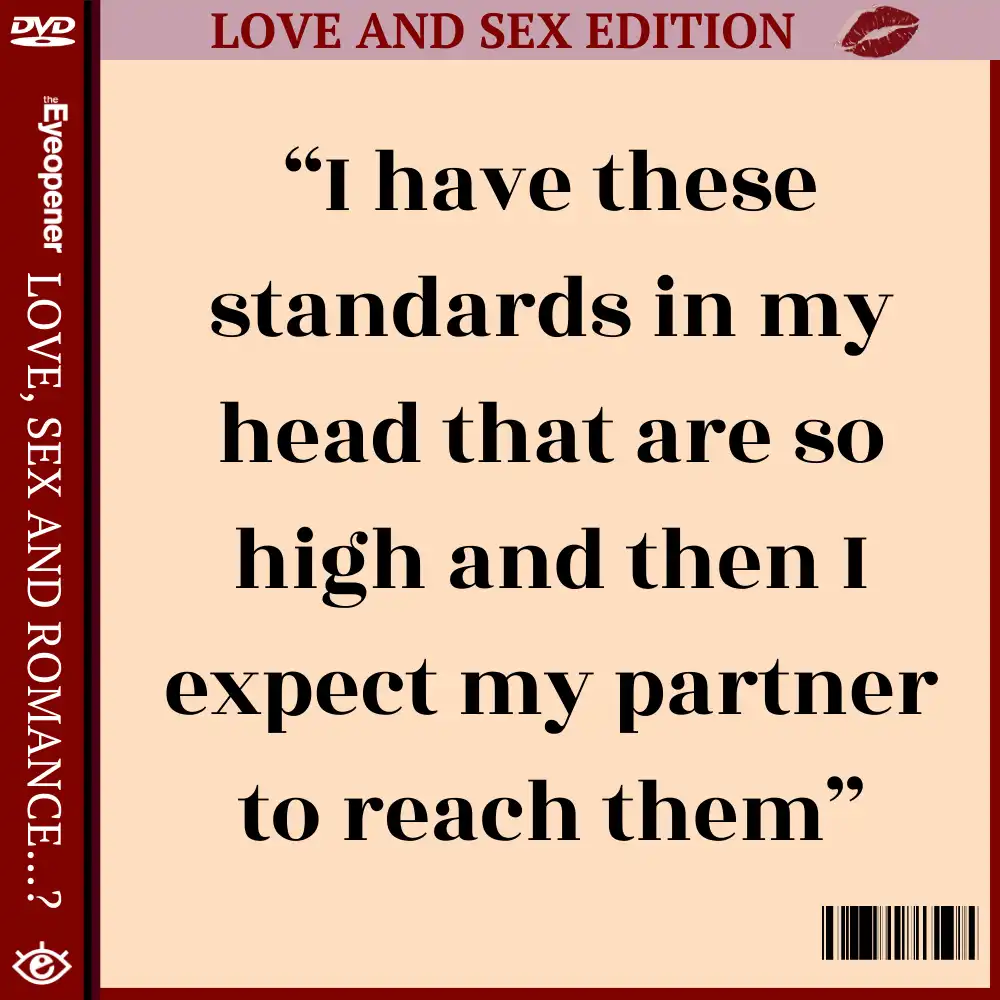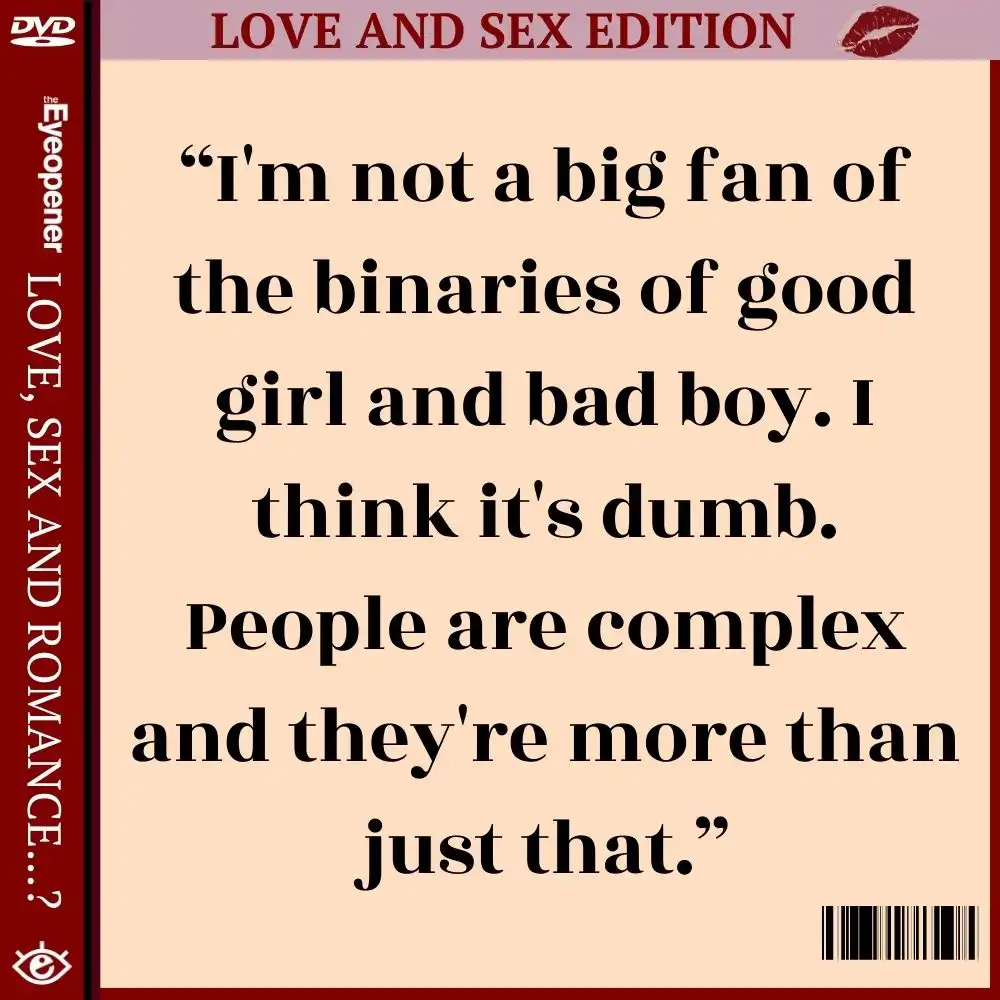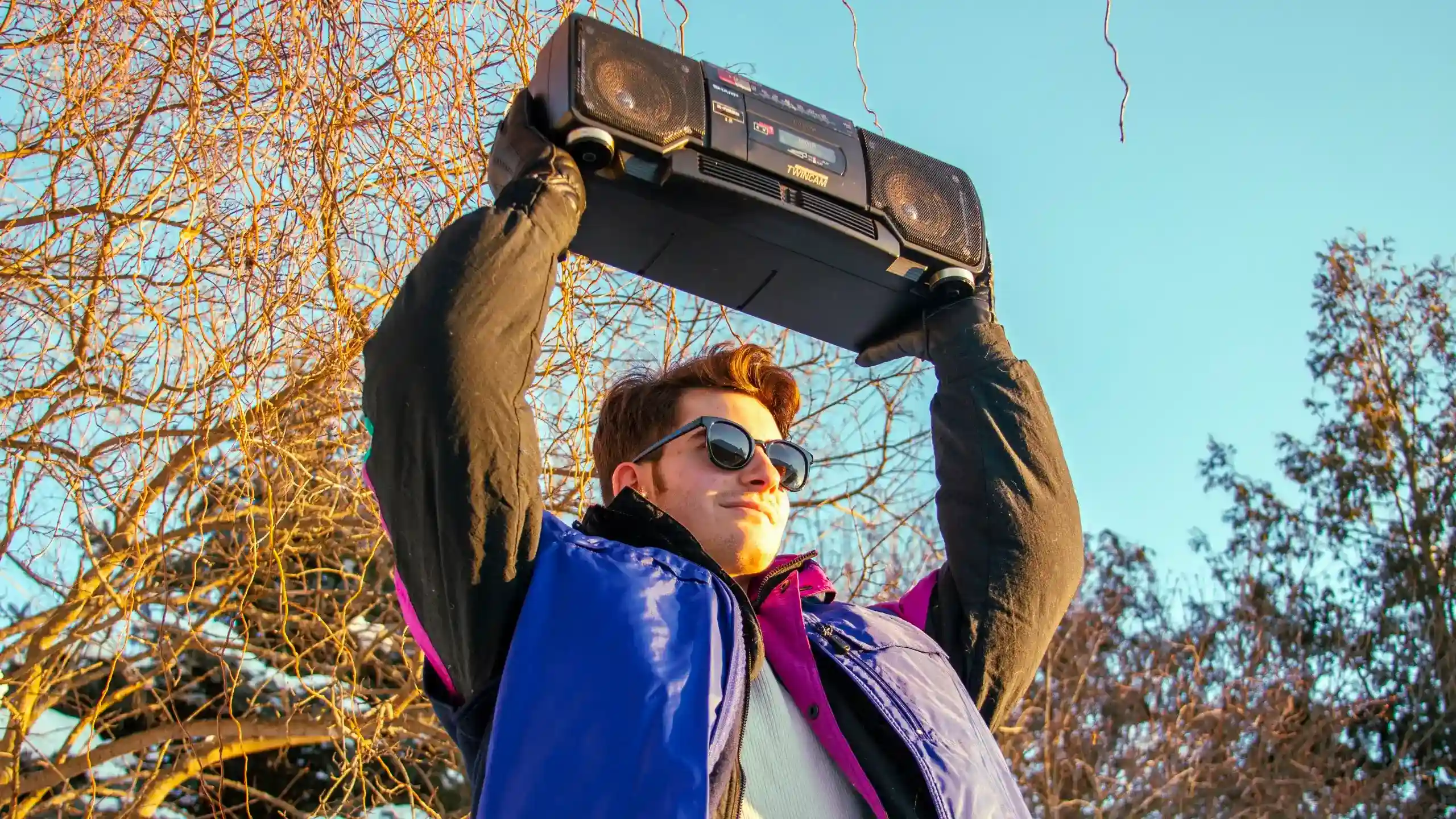“I have a theory,” begins the 2021 film The Hating Game. “Hating someone feels disturbingly like falling in love with them. Your stomach twists and flips, your appetite and sleep are shredded, your heart beats heavy and bright, nearly visible through your flesh and clothes.”
That’s the feeling that keeps third-year Toronto Metropolitan University (TMU) graphic communications management student Rache Dijamco coming back to a beloved movie genre: romance. More specifically, her favourite trope: enemies to lovers.
Dijamco experiences the emotions of the female lead viscerally even though she’s on the other side of the screen. The nervous jitters, the butterflies in her chest, the knots in the bottom of her stomach. The most exciting part for her is deciphering between a character’s external loathing and their internal infatuation. She loves the way characters can easily go from hating each other’s guts to falling madly in love.
But as much as movies like these excite her, they also have warped her perception of what a real relationship looks like.

In the past, Dijamco says she would intentionally sabotage her relationship by creating conflicts to see how she and her boyfriend would resolve them. On a very average morning, Dijamco woke up after falling asleep on the phone with her boyfriend of six months. She checked in with him before she went to work, wishing him a good day and telling him she loved him. Everything seemed normal.
A few hours later, she texted him saying that she thought he had “changed” and questioned why he was no longer as affectionate as he used to be.
“It is probably the most toxic thing I’ve ever done,” she says. “I didn't really feel like he changed…but I kind of made it a big deal just to see how he would react.”
Dijamco expected her boyfriend to apologize profusely and reiterate how much he loved her but instead, he defended himself and said he didn’t feel the need to constantly show affection when they had only been dating for half a year. “That triggered something in me,” Dijamco says.
Looking back, she can now see how he was speaking logically but all she wanted at the time was reassurance. In her favourite movies, after every big, dramatic fight, there is always a resolution. Dijamco was confused as to why that wasn’t happening in her real life.
In hindsight, Dijamco has realized that her favourite romance movies and books have negative effects. She’s often spent too much time in her past relationships comparing her boyfriends’ actions to the extravagant proclamations of love she sees in entertainment. Dijamco’s consumption of these movies and books have led her to think that grand gestures are the only way to express love, so when she doesn’t experience them, she questions her partner’s affections.
“I have these standards in my head that are so high and then I expect my partner to reach them,” she says. And when they don’t, she wishes she could ask them: “Do you even love me?”

Avid consumers of romantic films and novels can base their expectations for real-life relationships on what is presented to them in the media they consume. Fiction portrays a simplified and condensed version of reality, so using it to form one’s expectations will often be unsuccessful because humans are much more nuanced than imagined characters.
Due to the increasing popularity of these portrayals of romance, it’s no surprise that the genre has great influence over some TMU students. Students say while romance movies and novels can offer unrealistic expectations, they also provide a much-needed escape and outlook on love they don’t always get in real life.
For some, like Dijamco, romance can skew their perception of love and relationships. “The challenge is we have these expectations that are depicted by movies and the media,” says Allison Villa,
a psychotherapist and relationship expert based in Toronto.
Villa says many romance stories involve some sort of struggle that the main characters must overcome. But in the resolution, they almost always have a happy ending.
In real life though, “that is not exactly how it works,” she says.
For others, the romance genre, while sometimes unrealistic and exaggerated, can allow viewers to live vicariously through the characters they're watching. A 2019 journal article published in
Research in Human Development, explored this in an analysis of Asian American representation in film. The article explained that the media we consume impacts our identity development, which “is a fundamental cognitive, social, and developmental task related to understanding one’s place in the social world.” Romantic films have not always been diverse, but shows like
Bridgerton and movies like
To All The Boys I’ve Loved Before, which feature Asian leads, are changing that.
Still, as TMU students immerse themselves in romance, it's important for them to understand the difference between which parts of the fantasy are realistic and which parts are fabricated for entertainment purposes. Villa says the conflicts in a story are only relatable to a certain point.
“We do need to have expectations, that's very important,” Villa says. “But [we need to] tease apart the difference between what you personally expect versus what you have been told to expect.”

As a fan of the romance genre, Amna Ahmed says she finds comfort in seeing herself on-screen. Growing up as a young woman of colour in a predominantly white elementary school in Maple, Ont., the first-year criminology student was always very aware that she stood out. The shalwar kameez she wore to school or the daal chawal her mother packed for her lunch were strikingly different from her peers who wore t-shirts and brought in Lunchables.
Ahmed never felt like she fit in or was the object of any of her crushes’ desires because she didn’t meet the Eurocentric beauty standards that her classmates were familiar with. That was until she moved to Saudi Arabia with her family in the fifth grade and went to an international school with students from various backgrounds and cultures. She then realized boys were attracted to her.
Ahmed’s experience is why she found the second season of the Netflix series Bridgerton so impactful. It mirrored her own journey of self-acceptance and highlighted the appeal of a main character who looked like her.

“I was so incredibly happy,” she recalls. “When I think of movies that have a Brown girl as a lead, I think they revolve her entire personality [around] her ethnicity.”
In contrast, Kate and Edwina Sharma of Bridgerton, two sisters who are the main characters of the second season, have their own plotlines that have nothing to do with their South Asian heritage. They are both pursued by Lord Anthony Bridgerton, an attractive, affluent and wealthy bachelor, who is desired by every woman in their town. Despite how many other women throw themselves at him, he can’t help but fall in love with Kate Sharma, even when he tries to stay away from her.
“It's nice to see Brown women who are strong and beautiful and they're being lusted over,” Ahmed says. “They're seen as beautiful and their traditions are seen as something beautiful as well. It’s complementary to them but not the only important thing about them.”
Ahmed says having representation where a woman of colour is the object of a man’s desire makes her feel the same way her experience at the international school did: validated. Growing up, Ahmed felt like she’d never experience the kind of romance white female leads did on-screen. Now, shows like Bridgerton are changing that narrative in her mind.
“You realize that you're not that different, that your ethnicity is something that's complementary to you and not the only important thing about you,” she says. “It doesn't set you apart.”
Like Ahmed’s experience watching
Bridgerton, researchers found that seeing your culture and ethnicity represented on-screen can change the way you think about yourself. A study published in the
International Journal of Communication in 2017 compared the effects of varied representation in ethnic and mainstream media. The data found that when ethnic minorities are exposed to positive representation in the media they consume, both their self-esteem and their pride increases.
Along with adding more ethnic representation, movies and TV shows have also shifted to consider more than just the male perspective.
When Ahmed watched the 2019 film Little Women for the first time, there was one particular scene that stood out in her memory. Her eyes were glued to the screen with awe as Amy, one of the film’s female leads, asked Laurie, the male lead, to unbutton her painter’s apron. Standing behind her, his hands untied the fabric as his eyes gazed intently at the nape of her neck. Ahmed was amazed by how gentle Laurie was and how the scene depicted him as being so soft and tender in his actions.
For Ahmed, this scene is an example of what she loves most about romantic movies: the female gaze. Growing up, Ahmed remembers being aware that there were some things that women were attracted to that men didn’t know of, although she only learned that the female gaze and the male gaze were terms to represent this as she got older.
“The male gaze” is a term coined by author Laura Mulvey in her 1975 essay titled
“Visual Pleasure and Narrative Cinema” to explain how in narrative films, men are usually the ones actively looking and receiving pleasure, while women are being watched and providing this pleasure. This patriarchal idea means that films have traditionally been made with a primarily male audience in mind, which also skews how heterosexual relationships are presented because they only consider the man’s needs and desires. Villa says that it’s important to represent both roles in a relationship.
“In our design as human beings, there is equal importance to masculine and feminine energy,” Villa says. “What has been missing in representation [in movies] is that the masculine energy can be…the provider, the protector and be emotionally intelligent and communicative.”

In Villa’s opinion, having a balance of perspectives is where relationships find the most alignment and ease. Films that normalize an exaggerated form of masculinity also normalize unequal relationships, which are bound to be unhealthy in real life.
When thinking of the male gaze, Ahmed brings up the
Marvel franchise, which has only had two female directors out of its 27 directors since 2008, according to the
Internet Movie Database. Ahmed remembers watching the
Thor franchise which focuses on the physical strength and violent power of the male lead. In contrast, when she watched the 2021 film
Black Widow that had a female lead, she felt the movie focused on her body which was “perfect and not nearly as muscular as the guys.”
The exaggerated use of aggression and violence in these characters is what Ahmed indicates to signify the male gaze. While she says each individual person is attracted to different qualities, she believes the female gaze is deeper and more meaningful than physical actions. In fact, she says overpowering masculinity is unattractive to many women who see that aggression as a scary and dangerous sign in their real lives.
In contrast to the male gaze, the female gaze is a complete reversal which focuses on women as the intended audience. “When I think of the female gaze, I think of the interactions in Little Women which are so wholesome and light,” Ahmed says.
The female gaze embraces male characters who have qualities like thoughtfulness and emotional intelligence. “It doesn't need to be a big spectacle for it to mean something to the girl,” she adds. “When I think of the male gaze, I think of them making grand gestures and being strong, when that's not necessarily the things that we always find attractive.”

Third-year social work student Sofia Alda has a vivid memory of her first time watching the 2002 film A Walk to Remember. The movie played on a small TV in the corner of her tenth grade religion class at her high school in Mississauga. Her fellow students chattered away quietly over the TV’s speakers until one particular moment when the class went silent. Everyone’s eyes were glued to the screen as the movie’s main character, Jamie, stood on a deserted road while the male lead, Landon, told her she achieved an item on her bucket list. As she stood on the border between North Carolina and Virginia, she had accomplished her goal of being in two places at once .
“I bawled in the middle of class. It's something so small and so pure,” Alda recalls. “The selfless aspect of dating is what really stuck with me, that people can actually do something for somebody else because they love them.”
These small moments of intimacy are not incredibly popular in romantic films but Villa believes they can be the key to a healthy relationship in real life. She says people often undervalue that consistent quality time is the foundation to a long-term relationship. From a psychological perspective, she says most people’s brains return to the first place we experienced love, which was in our homes as children.
“That safety, that consistency, it comes from your parents and we know that it's not romantic,” Villa says. “It is challenging for many to hold the erotic and the desire with stability and safety.”

Villa explained that stability and safety are not present in the relationships we see in movies and television because all of those storylines require plots with conflict. In her opinion, the exact opposite of a healthy relationship is presented as the norm in the media.
“The fire, the thing you can't have, that's where that sexual energy lies,” she says. “But what is missing is the deep intimacy that lives in a healthy long-term relationship.”
Alda also remembers watching the 2010 film Letters to Juliet with her mother and sister when it was released in theatres. She was only eight years old at the time but she immediately became infatuated with the film about a young journalist’s quest to reunite an elderly woman with her long-lost love. As an Italian and a huge Shakespeare fan, she latched onto the beauty of the city of Verona. More than that, she looked to the love story in the movie as an inspiration for her future relationships.
“It's very unique in the sense that they're both self-sufficient individuals,” Alda says about the film’s main characters Claire and Lorenzo. “Nobody is fixing each other. Everybody's meeting each other where they're at and that's love.”
Unlike most fans of romantic films and novels, Alda doesn’t subscribe to the traditional tropes presented in the media like enemies to lovers, fake-dating or forced proximity.

Although Dijamco says experiences in her love life aren’t always like the movies, there have been moments where she remembers feeling like they were.
Once on a second date with a boy she met at the gym, he pulled out his guitar and began to serenade her. They were sitting outside in his backyard under the glittering stars and she remembers being so overwhelmed by how romantic it was.
“No one has ever serenaded me before. I didn’t think that it was still something that could happen,” she recalls. Although that relationship never went anywhere, she still remembers the moment fondly because it was so magical.

Despite how romantic movies may have affected her perception of love, they also inspire her to continue hoping for the future. She’s aware that many romance movies and books are exaggerated, but still, they help her to believe that love like that is out there. And if she doesn’t find the ideal relationship she’s looking for, she says she won’t let that stop her from living her dream romance movie.
“If it doesn't happen to me, I can make it happen for myself,” Dijamco says. “The next relationship I get into, I'm not really gonna wait for them to do cute things for me. I'll do it for myself.”






